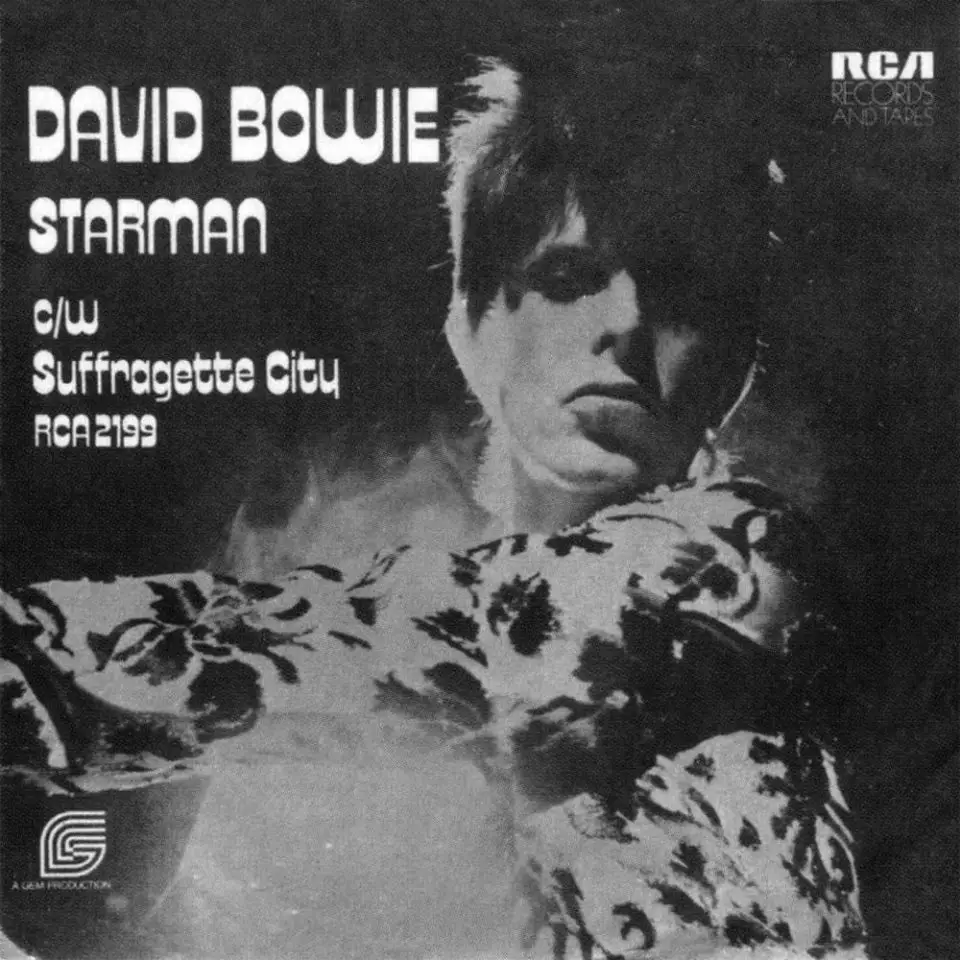The release
The ‘Starman’ single was released in the United Kingdom on 28 April 1972. Sales were initially slow, and it was at number 41 in the charts at the time of David Bowie’s game-changing Top Of The Pops appearance in early July.Bowie had not had a hit since ‘Space Oddity’ in 1969, and many assumed that ‘Starman’ was its follow-up – despite having released several albums and singles in the interim. Yet the new single cast off the image of the old long-haired singer-songwriter, and Bowie’s glam image spawned a legion of imitators.
The success of ‘Starman’ lifted the sales of Bowie’s back catalogue, and led to reissues of some of his earlier works. It also guaranteed interest in The Rise And Fall Of Ziggy Stardust And The Spiders From Mars, which was an instant hit upon its release.
Then ‘Starman’, backed with ‘Suffragette City’, was released as a single on 28 April in the UK. Suddenly we were on the radio again, and when the Ziggy Stardust album itself came out on 6 June it went straight in at Number 7, peaking at Number 5. Finally we were headline news.
Spider From Mars: My Life With Bowie
‘Starman’ raced up the charts following Bowie’s Top Of The Pops appearance. Its fortunes dramatically shifted afterwards, and the single peaked at number ten during its 12-week chart run.
The album, which had been released on 16 June, did even better, reaching number five on the album chart.
In the United States, ‘Starman’ fared less well, getting no further than number 65 on the Billboard Hot 100 in August 1972.
‘Starman’ was performed just once by Bowie for a BBC radio session. On 22 May 1972 he and the Spiders From Mars taped a four-song set for the Johnnie Walker Lunchtime Show on BBC Radio 1. ‘Starman’ kicked off the set, followed by ‘Space Oddity’, ‘Changes’, and ‘Oh! You Pretty Things’. The session was first broadcast on 5 June 1972, and ‘Starman’ was later selected for inclusion in the Bowie At The Beeb collection.
The song’s legacy
By Ziggy, we were all focused. We all lived in Haddon Hall. David was writing almost on a daily basis, He’d just started writing on the piano. I love ‘Starman’ as it’s the concept of hope that the song communicates. That ‘we’re not alone’ and ‘they’ contact the kids, not the adults, and kind of say ‘get on with it’. ‘Let the children boogie’: music and rock ‘n’ roll! It lifted the attention away from the depressing affairs in the ’70s, made the future look better. ‘Starman’ was the first Bowie song since ‘Space Oddity’ with mass appeal. After ‘Starman’, everything changed.
Uncut, March 2008
‘Starman’ was performed occasionally during the Ziggy Stardust Tour in 1972-3, and during a handful of the Sound + Vision Tour dates in 1990.
It was brought back into Bowie’s live set in the year 2000, for his Glastonbury Festival appearance and the warm-up shows, as well as an appearance on the TV show TFI Friday on 23 June.
Between 2002 and 2004 ‘Starman’ was performed a total of 25 times during the Heathen and Reality tours. The final live performance was on 11 April 2004 at Kelowna, Canada, when it opened the encore.
‘Starman’ became a staple of Bowie’s career-spanning compilations. The initial single mix, with the louder Morse code section, was not issued on compact disc until 2014’s Nothing Has Changed.
A 40th anniversary picture disc 7″ single of ‘Starman’ was released for Record Store Day on 21 April 2012. This contained the original single version on one side, and the Top Of The Pops version on the other. Released in the UK, Europe and USA, it was limited to just 2,000 copies and is now highly collectable.
On 16 June 2022 a new Ken Scott mix of ‘Starman’ was uploaded to YouTube. It combined the backing track and backing vocals, recorded for Top Of The Pops at Trident Studios on 29 June 1972, with Bowie’s 4 February vocals from the Ziggy Stardust album.
On 27 September 2022 Bowie’s handwritten lyrics for ‘Starman’ were sold at auction for £165,000 (£203,500 including the buyer’s premium). The initial estimate had been just £40,000. The purchaser was the Museum of Old and New Art (Mona) in Tasmania, Australia.
The sheet had been written by Bowie to allow his music publishers to prepare the printed lyrics on the Ziggy Stardust album. It was sold in the 1980s and loaned to the V&A museum for the David Bowie Is exhibition from 2013 to 2018.





Incredible song. The rhythm and meter of the lyrics sung in each verse are so unusual and yet feels perfectly right. I never fully read them until today and was quite moved by them. It’s a very melancholy song. This may sound strange but there’s an odd connection to early Neil Diamond’s songwriting and early Bowie songwriting style. Don’t know if anyone else hears a connection.
I love this site. Here in New York City I often can’t sleep at night and when that happens I thoroughly enjoy reading through your beautifully written, highly informative pages. Thanks Joe for all the work you put into this. It’s a masterpiece! Cheers!